Container air defense missile system project from Invariant Corporation and HDT Global (USA)
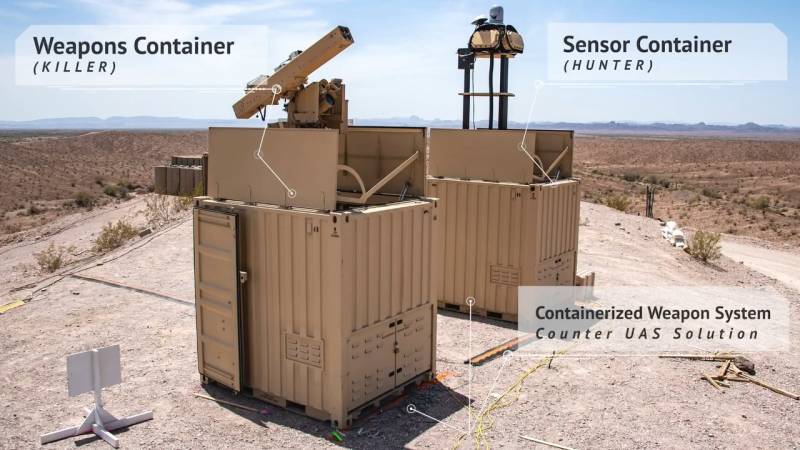
General view of a container air defense system in combat position
The United States continues to develop specialized air defense systems to combat small-class unmanned aerial vehicles. Not long ago, the Pentagon conducted demonstration tests of several new models of this kind with various features. Of particular interest in this series is the anti-aircraft missile system from the companies Invariant Corporation and HDT Global. It was built on the basis of ready-made and available units, while ensuring high performance characteristics.
Tests in the desert
At the beginning of the year, the Pentagon launched a new program to develop specialized air defense systems to combat UAVs. Organizations participating in the program had to develop, build and submit new air defense systems or other systems for testing as soon as possible. In order to speed up development and possible future production, it was necessary to make maximum use of off-the-shelf and available components.
The first results of this work were demonstrated in early September during joint exercises between the US and Saudi Arabian armies. As part of the Red Sands 23.2 event, demonstration and comparative tests of nine new air defense systems from different developers took place at the Shamal-2 training ground. The military of the two countries had the opportunity to get acquainted with new American developments, and industry showed the latest ideas and products.
The comparative test program was quite simple. Unmanned targets of standard models, in service with the US Army, were sent towards the area covered by experienced air defense. Anti-aircraft weapons were supposed to detect and hit them. At the same time, the progress of combat training work was recorded and various data were collected for subsequent analysis.
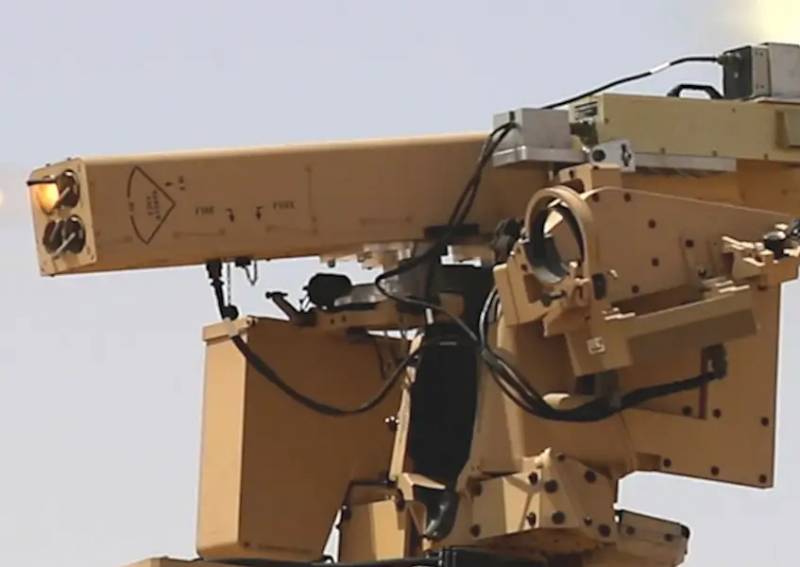
APKWS II Missile Launcher
Following the results of the exercises, the Central Command issued a press release in which it highly appreciated the activities carried out and their importance for the development of military air defense. However, no details were provided. In particular, the full list of program participants and developers of new technology, the features of the presented samples and the results of comparisons remained unknown.
However, some data still became publicly available. The US Army and specialized publications later showed some of the prototypes involved in the exercises and talked about them. As it turned out, very interesting samples were used in the tests.
Defense in containers
One of nine promising anti-aircraft systems designed to combat complex air targets was proposed by Invariant Corporation and HDT Global. As the customer required, they made extensive use of standard products and off-the-shelf components from other companies in their project. In this way, an air defense system with a characteristic appearance was created, significantly different from other models of its class.
The official designation of the new complex remains unknown. In press publications, the name is used, collected from the designations of key units - CROWS II / LAND-LGR4. Probably, if the project gets development, the developers will still reveal its name. In addition, if there is interest from the Pentagon, a new military designation may be introduced.
SAM CROWS II/LAND-LGR4 from Invariant Corp. and HDT Global has an interesting architecture. In order to simplify transportation and deployment, the main equipment of the complex is mounted in two standard 10-foot containers. One houses the detection equipment, and the second contains the launcher. In the stowed position, all devices and instruments are stowed inside the container, and in the working position they are pulled out through the opening roof.
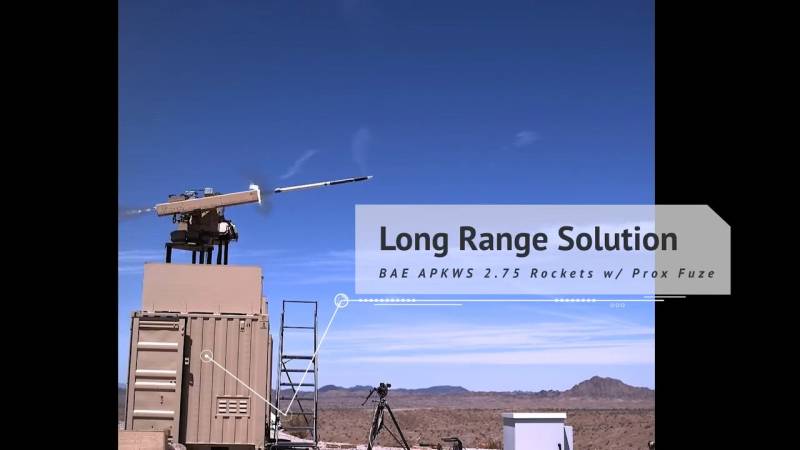
Start of a rocket
The container with the detection equipment is designated Hunter. It accommodates a lifting base with a Leonardo RPS-42 radar antenna unit and an optical-electronic system. The radar has four compact phased arrays, giving a viewing range of up to 30 km, depending on the target parameters. All-round visibility is provided with elevation angles from -10° to +70°. OLS is designed for more accurate tracking of targets in the near zone.
The second container is called “Killer” and has a similar lifting mechanism. The latter contains the CROWS II remote-controlled combat module from the Norwegian company Kongsberg. Two types can be mounted on the module weapons. The LAND-LGR4 launcher with four guides for 70 mm missiles is considered as the main one. The use of a 7,62 mm M134 multi-barreled rapid-fire machine gun is also proposed.
In its missile configuration, the CROWS II / LAND-LGR4 air defense system uses APKWS II type ammunition. Essentially this is aviation Hydra 70 unguided missile with a new WGU-59/B control unit based on a semi-active laser homing head. The missile's flight is controlled and the target is illuminated by a standard rangefinder-target designator of the CROWS II DBM. When launched from a ground platform at an air target, such a missile has a range of no more than 5-6 km.
All means of the new air defense system are connected to the operator's console. It can be placed away from containers in a convenient location. It is also envisaged to unite several “hunters” and “killers” into a network structure with the control of the forces of one team.
The developers claim that the container air defense system has high performance characteristics. With the appropriate transport, it can be deployed and used by just two operators. It takes about half an hour to unload and prepare for work. After this, long duty is possible. Rolling up and transporting to a new position should also not cause difficulties.
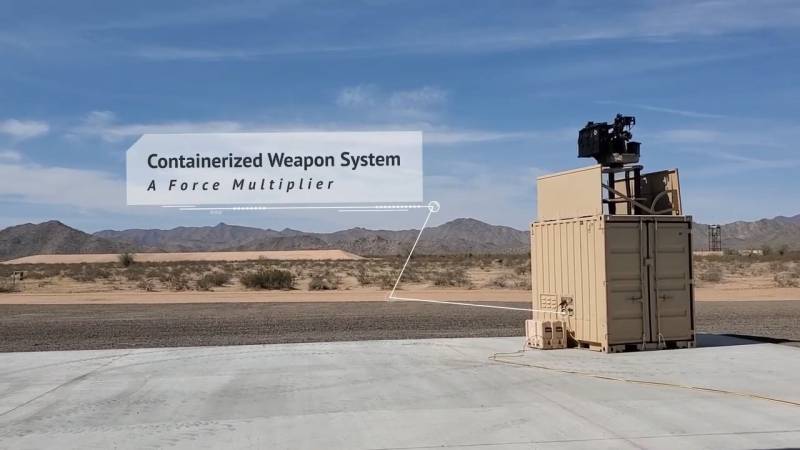
Machine gun version of the container
Optimal Solutions
An anti-aircraft missile system for combating UAVs from Invariant Corporation and HDT Global, apparently, may be of great interest to a potential customer. It has several characteristic features and advantages over other equipment and, as tests have shown, is capable of solving intended combat missions. At the same time, the characteristic appearance of the complex also attracts attention.
The main competitive advantage of the new CROWS II / LAND-LGR4 air defense system may be the simplicity and low cost of its production and operation. It uses only off-the-shelf components and ammunition that are already mass-produced and in service with the US Army. Accordingly, the launch of production, delivery and development of the complex will not be associated with any difficulties and will not require an excessive amount of time.
The idea of equipping the serial CROWS II DBM with a missile launcher is of interest. This product is standardly equipped with machine guns and grenade launchers of various models, but missiles have not yet been installed on it. As recent tests have shown, this option for equipping the module is also possible and is capable of coping with its tasks.
The main ammunition of the new air defense system is seen as the Hydra 70 aircraft missile with a new control unit. Such ideas have been proposed and implemented previously, and specifically in the context of combating UAVs. It is argued that the modified Hydra is quite capable of defeating such targets - provided there is reliable target designation. In addition, it is possible to fire at ground targets. However, the real effectiveness of this rocket may be limited due to low flight data, low mass and other factors.
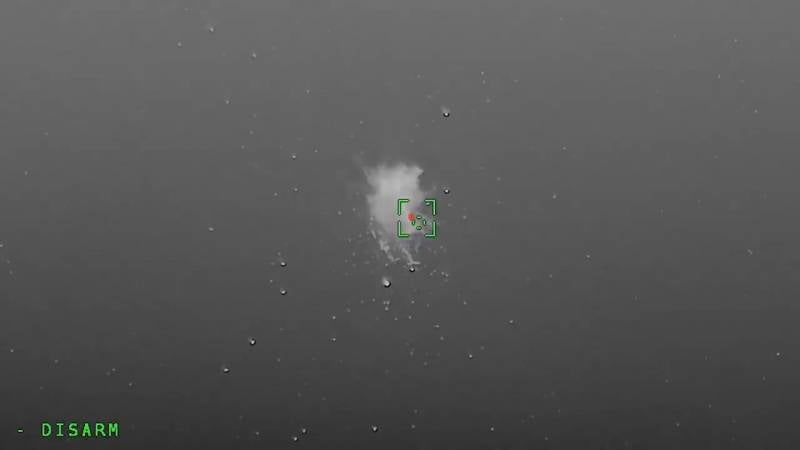
Target hit
With all this, the Killer container can, in theory, carry a DBM with machine gun armament. In this case, it is possible to create a short-range anti-aircraft missile and machine gun system. Containers with different weapons under the control of one central post will be able to show more interesting results.
However, the CROWS II / LAND-LGR4 complex also has obvious disadvantages. So, you shouldn’t expect high survivability from it. The containers are made of structural steel, which limits the level of protection of the internal equipment, and the key elements of the retractable devices do not have armor at all. Accordingly, any gap nearby or shelling threatens this air defense system. In particular, shock-loaded UAVs or kamikaze vehicles that manage to break through the defense pose a danger to it.
The complex is proposed to be armed with missiles or a machine gun with a limited launch/firing range. It is assumed that modern control systems will provide a high probability of hitting a target, but the actual characteristics of this kind remain unknown. Moreover, the survivability and efficiency of the complex as a whole depends on them. However, it is assumed that the weapons used will make it possible to effectively destroy UAVs that do not have outstanding flight characteristics.
New experiments
Thus, the Pentagon and its contractors continue to search for new solutions in the fight against UAVs of the main classes that pose the greatest threat. The Army wants a simple, inexpensive and effective counter-unmanned aircraft system that can be mass-produced and deployed at various sites. Right now the next stage of creating such systems is underway.
The recently presented air defense missile system project from Invariant Corporation and HDT Global generally meets the customer’s requirements, but it has yet to confirm all the design characteristics. If this happens, the US Army can count on strengthening its air defense. At the same time, it cannot be ruled out that the CROWS II / LAND-LGR4 system will be surpassed by other modern developments. In the September tests, nine different complexes were used at once, and each of them has a chance of winning.
Information